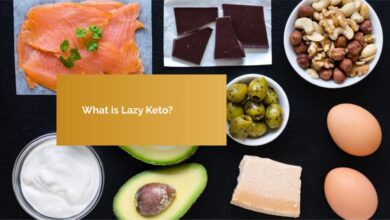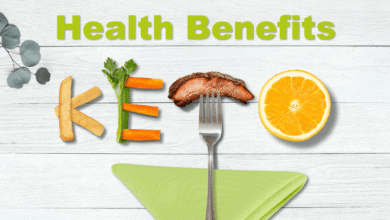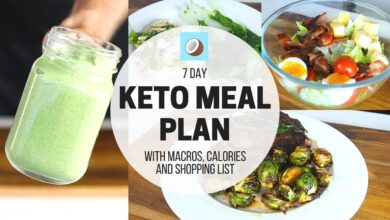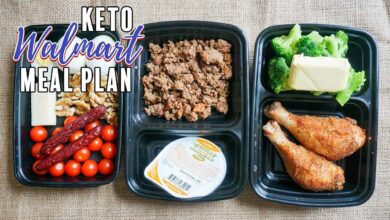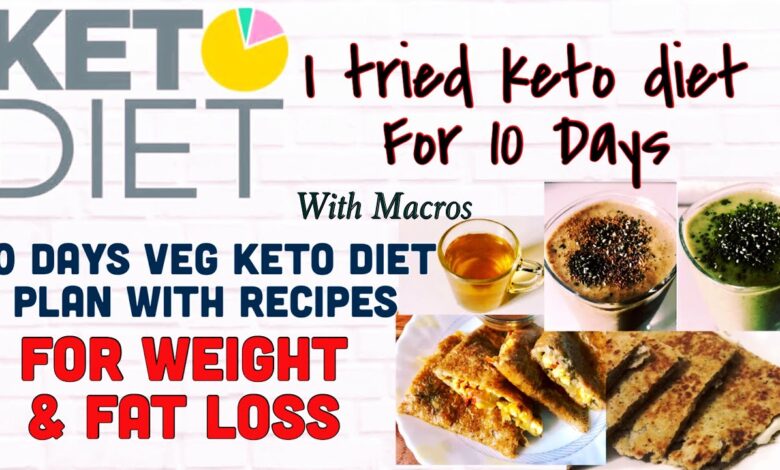
Starting a keto diet can feel like stepping into a whole new world—macros, ketosis, carb counts, net carbs, fat bombs. But get past the initial fog, and the rewards—stable energy levels, better mental clarity, appetite control, and fat loss—can be profound. In this comprehensive guide, I’ll walk you through 7 essential tips for beginners on the keto diet, explaining not just what to do, but why it works, how to stick with it, and what pitfalls to avoid. Buckle up—let’s dive in!
Read Also “5 Simple Keto Diet Plans for Weight Loss Success | Best Keto Plans 2025”
What Is Keto and Why It Works
“Keto” is shorthand for ketogenic, meaning your body is running on ketones instead of glucose. That shift happens when you drop dietary carbs low enough that insulin falls, and your liver begins converting fat into ketones. Those ketones then fuel your brain, heart, and rest of your body. In simple terms: you flip the switch from sugar-burning mode to fat-burning mode.
Why do people love keto? Because it empowers your metabolism. Instead of riding carb crashes, you’re more likely to feel stable energy, reduced cravings, and better appetite control. Numerous studies have shown benefits for weight loss, type 2 diabetes management, neurological support, and more. But—and this is key—the first few weeks are the hardest. You’ll rewire your metabolism, and that takes patience, consistency, and knowledge.
When you’re beginning, confusion abounds. Which foods are “keto-friendly”? How low do carbs have to go? Is all fat fair game? What about side effects? That’s where our 7 essential tips come in. If you follow them, you’ll set yourself up for success rather than frustration. Throughout this guide, I’ll also drop in links to deeper resources so you’re not stuck Googling basic definitions (for example, this post on how to calculate keto macros or that one on electrolytes during keto).
Let’s get started by nailing your macro blueprint.
2. Tip 1: Calculate Your Macros Precisely
Hitting the Right Ratio
One of the most common pitfalls beginners make is a vague approach to “eat low carb, eat fat.” But the success of keto often comes down to hitting macros—the precise ratios of fat, protein, and carbs. A typical starting point is:
- 70–75% calories from fat
- 20–25% from protein
- 5–10% from carbs
If you prefer grams: many beginners aim for 20–30 g net carbs, moderate protein (e.g., 0.6 to 1.0 g per pound of lean body mass), and the rest from fat. Of course, individual variation matters—age, sex, activity level, metabolic health all influence the “sweet spot.”
With correctly calculated macros, you guide your body into consistent ketosis without confusion or guesswork.
Tracking vs “Estimating”
You have two choices: track every gram or eyeball it. For serious beginners, I strongly encourage tracking for at least 4 to 8 weeks. Apps like Carb Manager, Cronometer, or MyFitnessPal (with modifications) can auto-calculate your macros and alert you if you’re going off track. Track everything: cooking oils, hidden carbs (like in sauces), and even “zero” carb foods that may have trace amounts.
Once you internalize the proportions, you can estimate by meal patterns. But early discipline ensures you don’t wander off and get discouraged.
3. Tip 2: Prioritize Healthy Fats
Fats are the fuel on keto. But just because keto gives fats a VIP ticket doesn’t mean all fats are your friends. Let’s break down good vs bad.
Types of Fats That Heal vs Harm
- Healthy fats: monounsaturated and saturated (in moderation) from natural sources—olive oil, avocado, coconut oil, grass-fed butter, ghee, MCT oil, fatty fish, nuts, and seeds.
- Less ideal fats: processed seed oils (e.g. soybean, corn, cottonseed, canola in industrial forms), trans fats, margarine, hydrogenated oils, etc.
While saturated fats have been demonized historically, on keto the context changes: when your insulin is low, your body uses saturated fat more efficiently and is less likely to deposit it adversely. Still, diversity in the types of fats adds resilience (and flavor).
Fat Sources for Keto Beginners
When you’re starting, aim for:
- Olive oil / extra virgin olive oil (for dressings)
- Avocado oil / olives / avocado
- Coconut oil / MCT oil (especially for bulletproof coffee or in small quantities)
- Grass-fed butter / ghee
- Fatty fish (salmon, mackerel, sardines)
- High-fat dairy (cheese, cream, full-fat yogurt)
- Nuts & seeds (macadamia, pecan, flax, chia)—but mind their carbs
Make it enjoyable. Use oil drizzles, creamy dressings, sauces, or fat bombs so fat isn’t a burden but a pleasure.
4. Tip 3: Keep Carbs Ultra Low and Smart
Net Carbs vs Total Carbs
On keto, the concept of net carbs is critical—total carbs minus fiber and sugar alcohols that don’t impact blood sugar. For many, the “magic number” is ≤ 20 g net carbs daily to reliably remain in ketosis. Some more flexible starters aim for up to 30–50 g net carbs, but risk fluctuation.
When reading labels, subtract fiber (and sometimes erythritol or other non-impacting sugar alcohols). But be cautious—maltitol and sorbitol can still spike blood sugar in some people.
Carb “Leakage” Foods to Watch
Hidden carbs are everywhere:
- Sauces, dressings, condiments (ketchup, BBQ, sweetened mayo)
- Low-fat dairy (often more sugar)
- Processed “keto snacks” (double-check ingredients)
- Alcoholic drinks (beer, sweet wines, cocktails)
- Nuts & seeds in large quantities
Even a tablespoon of honey or a splash of orange juice can derail a day. Read labels, prep your own, and keep a carb log.
5. Tip 4: Moderate Protein, Don’t Overeat
It might sound counterintuitive—but too much protein can hinder ketosis because the excess can convert (via gluconeogenesis) into glucose, raising insulin. Beginners often overdo the “eat all the steak” logic.
Why Too Much Protein Can Stall You
Think of protein like a thermostat. A little regulates repair, growth, and hormone synthesis. But once you overshoot, your body may shift gears and start producing glucose from that surplus, which can reduce ketone levels and stall fat adaptation.
Best Protein Sources
Focus on moderate amounts of:
- Grass-fed beef, lamb, pork, game meats
- Chicken thighs, duck, turkey (with skin)
- Fatty fish & shellfish
- Eggs & pastured eggs
- Full-fat dairy proteins (cheese, Greek yogurt, cottage cheese)
Pair them with fat—that’s your “secondary fuel,” not your main dish all the time.
6. Tip 5: Hydration, Electrolytes & Minerals
Keto Flu: Real Causes & Remedies
As you deprive your body of carbs, water and electrolytes flush out faster. Glycogen stores (which hold water) drop, kidneys excrete sodium, and you lose fluid quickly. That’s why early days often come with headaches, fatigue, muscle cramps, and brain fog—collectively called “keto flu.”
You can prevent or soothe this by steadily replenishing fluids and electrolytes, not by forcing massive intake in one go.
How to Stay Balanced
- Drink plenty of water (0.5 to 1.0-ounce per pound of bodyweight)
- Add sodium (e.g. 2–5 g of salt daily)—sea salt, Himalayan salt
- Ensure potassium intake (leafy greens, avocado, magnesium supplements)
- Monitor magnesium (e.g. magnesium citrate, glycinate)
- Optionally, sip bone broth or keto-specific electrolyte drinks
By keeping these in balance, your energy remains steady, digestion remains healthy, and you dodge the worst of the flu.
7. Tip 6: Plan, Prep & Stay Accountable
As Benjamin Franklin said: “By failing to prepare, you are preparing to fail.” Keto is not immune to this truth.
Meal Planning Strategies
- Batch-cook proteins and fats (roasted chicken, grilled fish, fatty meats).
- Prep vegetables (wash, chop, refrigerate).
- Make keto sauces/dressings in bulk.
- Pre-portion snacks (nuts, cheese cubes, fat bombs).
- Have “go-to” staples (eggs, canned fish, avocados) available at all times.
When you open your fridge and all you see is lettuce and cheese, you’ll be more likely to reach for the wrong snack—so keep good choices ready.
Tracking Tools & Apps
- Carb Manager, Cronometer, MyFitnessPal (with custom macros)
- Keto-specific apps that track ketones, water, trends
- Spreadsheet logs or analog journals
Record daily intake, energy levels, sleep, and side effects. Over a few weeks you’ll see patterns and be able to fine-tune.
Social Support & Accountability
- Join keto groups on Facebook, Reddit, or local communities
- Pair up with a “keto buddy” to check in
- Share your progress on social media or a blog
- Seek expert support (nutritionist, coach) when needed
Having someone to remind you, help you troubleshoot, or celebrate wins makes the journey far easier.
8. Tip 7: Be Patient & Expect Adaptation
You didn’t gain fat overnight—and you won’t adapt to keto instantly either. There’s an adaptation phase (sometimes called keto-adaptation) that may last 2 to 6 weeks (or more) depending on your prior diet, metabolic health, and activity level.
Timeline & Milestones
- Days 1–3: Glycogen depletion, some energy dips
- Days 4–7: Keto flu symptoms peak
- Weeks 2–3: Ketone levels rise, energy stabilizes
- Weeks 4–8: Fat-adaptation deepens; workouts recover
- Beyond 8 weeks: you become “metabolically flexible”
Don’t panic if early progress is slow. Focus on consistency. If you slip one day, just reset the next—don’t throw out weeks of progress.
What Happens If You Cheat
A slip (e.g., a carb binge) will knock you out of ketosis, increase insulin, and temporarily reset your progress. But it’s not ruinous—as long as you return to your macros promptly. Learn from it: what triggered it? Could it be cravings, boredom, or lack of planning?
9. Advanced Tips & Tweaks
Once you’ve mastered basic keto, you can explore these tweaks:
Targeted Keto (TKD)
Consume a small number (e.g., 20–30 g) of fast carbs right before intense workouts to fuel performance without derailing ketosis.
Cyclical Keto (CKD)
Have “re-feed” days (e.g. once or twice a week) where you increase carbs to replenish glycogen—useful for athletes or high-intensity trainees.
Intermittent Fasting Integration
Many keto followers combine 16:8 or 18:6 time-restricted feeding windows. Fasting accelerates fat adaptation, simplifies eating, and can deepen ketosis.
Remember: only experiment once you’ve mastered the basics and feel consistent.
10. Common Mistakes & How to Avoid
Mistake #1: Thinking all keto foods are “safe”
You still need to read labels. Keto bars, “low-carb wraps,” and sauces may hide sugars or fillers.
Mistake #2: Neglecting fiber and micronutrients
Don’t live on meat and cheese only. Include leafy greens, low-carb veggies, and supplements when needed.
Mistake #3: Overdoing dairy for convenience
While cheese and cream are easy, too much dairy can cause inflammation, insulin reaction, or stall loss in some people.
Mistake #4: Relying too heavily on packaged “keto” products
They can be pricey, processed, and not always effective. Whole foods are usually better.
Mistake #5: Giving up too early
If you bail after two weeks, you won’t see the real transformation. That’s why patience matters.
11. Sample 7-Day Keto Meal Plan (With Recipes)
Below is a sample plan (you can scale, swap, or adjust to region and preference):
| Day | Breakfast | Lunch | Dinner | Snack / Dessert |
|---|---|---|---|---|
| Mon | Scrambled eggs with spinach & cheese, coffee with MCT | Chicken salad (lettuce, avocado, olive oil) | Grilled salmon with roasted broccoli | Fat bomb (cacao & almond butter) |
| Tue | Keto pancakes (almond flour) + berries | Beef taco bowl (no shell) | Butter chicken + cauliflower rice | Cheese & macadamia nuts |
| Wed | Omelet (mushrooms, cheese, bacon) | Tuna salad with olive oil | Pork chops + Brussels sprouts | Dark chocolate (90%) |
| Thu | Full-fat Greek yogurt + chia | Zucchini noodle stir-fry with shrimp | Lamb chops + sautéed greens | Berries + whipped cream |
| Fri | Bulletproof coffee + sausage | Caesar salad (no croutons) | Ribeye + asparagus | Keto mousse |
| Sat | Cottage cheese + flax seed | Burger (no bun) with salad | Roast chicken + veggies | Cheese crisps |
| Sun | Eggs Benedict (keto version) | Cobb salad | Beef stew (low-carb) | Keto cheesecake bite |
Each day, aim to hit your macros. Drink water, include vegetables, adjust fats to meet your targets.
12. Keto Diet in Different Regions (Africa, U.S., Europe)
Africa
In many parts of Africa, staples are high-carb — yam, cassava, plantain, rice. Transitioning may require new habits: meats, eggs, local fatty fish, avocados, coconuts, native greens (e.g. spinach, moringa). You may have to adapt to availability and cost.
United States
Abundant resources, packaged options, keto-friendly restaurants, and wide variety of meats, cheeses, and specialty foods are available. Use local farmers’ markets for grass-fed meats and organic produce to improve quality.
Europe
Eastern Europe has dairy culture (feta, yogurt) which helps; Mediterranean areas offer olive oil, fish, nuts. But carb-heavy staples (bread, pasta) are everywhere. Be vigilant in reading labels (e.g., hidden sugar in sauces).
No matter where you live, the principles stay the same. Source what’s available locally, adapt recipes, and keep the macro fundamentals firm.
13. Keto for Special Populations (Women, Seniors, Athletes)
Women
Hormones (thyroid, estrogen, progesterone) are more sensitive; avoid too low calories. Some women prefer a more moderate-carb version initially (e.g. 30–40 g net carbs) and track menstrual cycle responses.
Seniors
Older adults have different muscle and metabolic needs. Include resistance training, ensure adequate protein, and monitor kidney function. Electrolyte and bone health is critical.
Athletes
Carb demand is higher. Use TKD or CKD strategies. Time carb intake around heavy training sessions. Monitor performance and recovery closely. Some elite athletes stay in full keto with adjustments, others prefer cyclical methods.
14. Monitoring Progress & Adjustments
Keep key metrics:
- Body measurements (waist, hips, etc.)
- Weight (but don’t obsess)
- Body composition (if possible)
- Blood ketone levels (blood meter or breath)
- Energy, sleep quality, mood
- Digestive health
If you stall for 2+ weeks, try:
- Lowering carbs further or rechecking hidden carbs
- Adjusting fat downward slightly (calories)
- Tweaking protein
- Reassessing electrolyte intake
- Taking a short strategic fast
- Re-committing to tracking / accountability
Always remember: setbacks are part of the process. The goal is long-term consistency.
Conclusion
Embarking on a keto diet for beginners is simultaneously exciting and challenging. But with the 7 essential tips above—precise macros, quality fats, ultra-low carbs, moderate protein, hydration, planning, and patience—you’ll dramatically increase your odds of success. Remember, it’s not about perfection; it’s about improvement over time. Stick with it, listen to your body, be flexible in adaptation, and use the tools and community around you. Your body is remarkably adaptive—give it time, and you’ll see change.
Read Also How to Start Keto Diet: A Beginner’s Weight Loss Blueprint with Proven Results
5 Unique FAQs
1. Is the keto diet safe for long-term use?
Yes, for many healthy individuals, keto can be safe long-term when well-formulated (nutritionally dense foods, electrolyte balance, regular health monitoring). Some medical supervision is prudent, especially for those with metabolic or kidney issues.
2. How will I know I’m in ketosis?
Signs include increased ketone breath or urine readings, reduced appetite, stable energy, clearer mental focus, and sometimes increased thirst. A blood ketone meter gives the most dependable reading (target ~0.5–3 mmol/L).
3. Can I exercise while on keto?
Absolutely—though early on, you might feel fatigue. Low-to-moderate efforts (walking, light cardio, strength training) adapt quickly. For high-intensity or endurance sports, you may experiment with TKD or CKD strategies.
4. What if I hit a weight-loss plateau?
First, re-check your macros for hidden carbs or extra calories. Then adjust: lower fat slightly (thus lowering calories), increase activity, ensure you’re getting quality sleep, manage stress, fine-tune electrolyte balance, or add a short fast.
5. Are there any people who shouldn’t try keto?
Yes. Pregnant or breastfeeding women, those with pancreatic disease, liver failure, fat metabolism disorders, or some types of kidney disease should avoid or approach keto only under medical supervision. Also, certain medications (e.g. insulin, SGLT2 inhibitors) may require adjustments when switching to keto.

